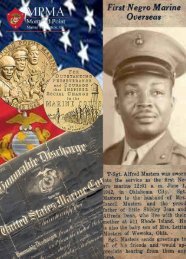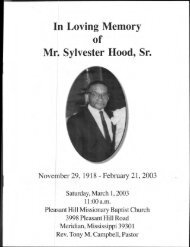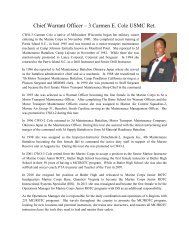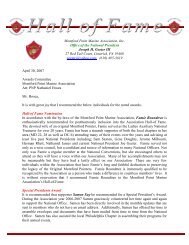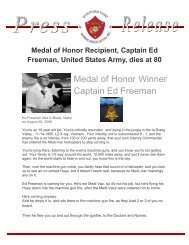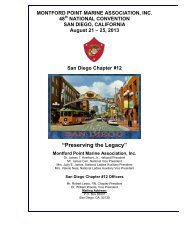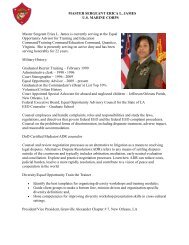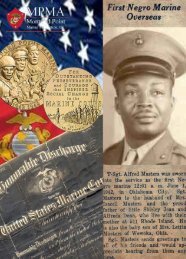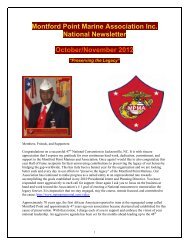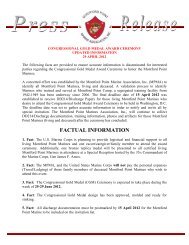Montford Point Marines - Montford Point Marine Association
Montford Point Marines - Montford Point Marine Association
Montford Point Marines - Montford Point Marine Association
You also want an ePaper? Increase the reach of your titles
YUMPU automatically turns print PDFs into web optimized ePapers that Google loves.
<strong>Montford</strong> <strong>Point</strong> <strong><strong>Marine</strong>s</strong><br />
Awarded the Congressional Gold Medal<br />
MGySgt Norman D. Epkin, USMC (Ret), one of the<br />
last <strong>Montford</strong> <strong>Point</strong> <strong><strong>Marine</strong>s</strong> to retire from active<br />
duty, returned to <strong>Marine</strong> Barracks Washington,<br />
D.C., where he was stationed in 1946, to attend<br />
the parade and award ceremony June 29, 2012.<br />
LtGen Willie J. Williams, senior active-duty African-American <strong>Marine</strong>, awards<br />
a replica Congressional Gold Medal to a <strong>Montford</strong> <strong>Point</strong> <strong>Marine</strong>. Some 430<br />
<strong>Montford</strong> <strong>Point</strong> <strong><strong>Marine</strong>s</strong> were awarded medals that were provided by the<br />
<strong>Marine</strong> Corps <strong>Association</strong> & Foundation.<br />
Story and photos by Clare A. Guerrero<br />
remember when I first went to<br />
the train station to go to basic<br />
“Ican<br />
training, and when I got to Union<br />
Station, I went to board the train, and the<br />
conductor said, ‘All blacks have to sit behind<br />
the coal car,’ ” said former Corporal<br />
James E. Brooks. He had to pause; the<br />
silence told all. Tears streamed down the<br />
face of the earliest <strong>Montford</strong> <strong>Point</strong> <strong>Marine</strong><br />
enlistee present at the parade and award<br />
ceremony at <strong>Marine</strong> Barracks Washington,<br />
D.C., June 29. “So that was just the be ginning.<br />
It was a great bunch of guys. And I<br />
fought for ’em,” he said.<br />
One day earlier, on June 28, the <strong>Montford</strong><br />
<strong>Point</strong> <strong><strong>Marine</strong>s</strong> were awarded the<br />
Congressional Gold Medal in a special<br />
ceremony at Emancipation Hall in the<br />
United States Capitol Visitor Center. <strong>Marine</strong><br />
veteran William McDowell was proud<br />
to accept the medal on behalf of all the<br />
<strong>Montford</strong> <strong>Point</strong> <strong><strong>Marine</strong>s</strong>.<br />
The Congressional Gold Medal, the<br />
high est civilian honor awarded as an expression<br />
of national appreciation for distinguished<br />
service and contribution,<br />
brought this group of “giants” into the<br />
spotlight—heroes who had served their<br />
country unceremoniously, many without<br />
promotion, and during segregation.<br />
“Today we gather to pay tribute, as the<br />
gold medal inscription says, to perseverance<br />
and courage of a small group of<br />
giants in American history, the <strong>Montford</strong><br />
<strong>Point</strong> <strong><strong>Marine</strong>s</strong>,” said Rep. Nancy Pelosi<br />
at the Capitol ceremony.<br />
“In an age of inequality, breaking the<br />
color barrier in the <strong>Marine</strong> Corps took<br />
noth ing less than perseverance, patriotism<br />
and courage of extraordinary proportions.<br />
Fighting for a segregated America re quired<br />
that extra dose of patriotism. Yet for the<br />
men of <strong>Montford</strong> <strong>Point</strong>, the reason to join<br />
the <strong><strong>Marine</strong>s</strong> was about something more<br />
basic. There was a war raging abroad, and<br />
they saw it as their duty to fight for their<br />
country. As one of the early recruits said,<br />
‘I joined the <strong>Marine</strong> Corps because I<br />
thought it to be the proper thing to do, to<br />
be patriotic to my country. I felt this was<br />
history in the making.’ ”<br />
“I don’t think we imagined that anything<br />
like this would happen in our lifetime,”<br />
said McDowell at the presentation. “It does<br />
sadden me that so many of our brothers<br />
are not with us here today. The upside of<br />
it all is that we do remember each and<br />
every one of them. They’re in our hearts<br />
and our minds. And they shall never be<br />
forgotten.”<br />
The following morning, at <strong>Marine</strong> Barracks<br />
Washington, the Commandant of the<br />
<strong>Marine</strong> Corps, General James F. Amos,<br />
hosted a parade and ceremony to honor<br />
the special contributions of the <strong>Montford</strong><br />
<strong>Point</strong> <strong><strong>Marine</strong>s</strong> and to award each with a<br />
bronze replica of the Congressional Gold<br />
Medal, which were paid for by a donation<br />
from the <strong>Marine</strong> Corps <strong>Association</strong> &<br />
Foundation.<br />
The event drew approximately 430 still<br />
tough-as-iron <strong>Montford</strong> <strong>Point</strong> <strong><strong>Marine</strong>s</strong> to<br />
the Barracks. Many were sporting wheelchairs<br />
parked in rows spanning the entire<br />
length of the parade ground. The <strong>Montford</strong><br />
<strong>Point</strong> “giants” withstood the sweltering<br />
18 LEATHERNECK SEPTEMBER 2012 www.mca-marines.org/leatherneck
<strong>Montford</strong> <strong>Point</strong> <strong><strong>Marine</strong>s</strong> make a presence at MB Washington—<br />
as rows of seats and wheelchairs stretch across the entire<br />
length of the parade ground.<br />
heat that even got the best of some<br />
members of the Barracks marching units.<br />
The ceremony opened with the reading<br />
of a statement by President Barack H.<br />
Obama attesting to the <strong>Montford</strong> <strong>Point</strong><br />
<strong><strong>Marine</strong>s</strong>’ service to Corps and country.<br />
Lead ing the parade, “The President’s<br />
Own” United States <strong>Marine</strong> Band played<br />
“Riders for the Flag” and “The Stars and<br />
Stripes Forever,” both composed by the<br />
legendary <strong>Marine</strong> “March King,” John<br />
Philip Sousa. Following the Barracks traditional<br />
parade sequence, the marching<br />
companies filed from the inner crevices<br />
of the barracks to come on line and then<br />
execute the “manual of arms” and follow<br />
with the presentation of the colors.<br />
During the formal presentation of the<br />
replica Congressional Gold Medals, senior<br />
<strong>Marine</strong> Corps leaders moved down the<br />
lines of <strong>Montford</strong> <strong>Point</strong> <strong><strong>Marine</strong>s</strong>, looping<br />
a ribbon holding a medal over the head<br />
of each <strong>Marine</strong>. Many <strong>Montford</strong> <strong>Point</strong><br />
Ma rines rose from their seats and wheelchairs<br />
to accept the medals; the honor<br />
was met with both smiles and tears.<br />
www.mca-marines.org/leatherneck<br />
During his remarks, Gen Amos shared<br />
with the attendees some meaningful details<br />
that contributed to the organization<br />
and coordination of the event, singling out<br />
Lieutenant General Willie J. Williams,<br />
the senior active-duty African-American<br />
<strong>Marine</strong>, and Colonel Stephanie Smith, for<br />
Many <strong>Montford</strong> <strong>Point</strong><br />
Ma rines rose from their<br />
seats and wheel chairs to<br />
accept the medals; the<br />
honor was met with both<br />
smiles and tears.<br />
their efforts in coordinating the event.<br />
Smith volunteered for the arduous task<br />
of tracking down the <strong>Montford</strong> <strong>Point</strong> <strong><strong>Marine</strong>s</strong>.<br />
The Commandant said he learned<br />
the significance of Col Smith’s dedication<br />
and perseverance to the project: her father,<br />
Ernie Smith, who was present in the crowd,<br />
went through boot camp at <strong>Montford</strong><br />
<strong>Point</strong>. Smith expressed immense pride that<br />
her father was a <strong>Montford</strong> <strong>Point</strong> <strong>Marine</strong>.<br />
Special recognition also was given to<br />
Rep. Corrine Brown from the 3rd District<br />
in Florida, and North Carolina Sen. Kay<br />
Hagan, for their contributions in getting<br />
the bill passed in the House of Repre senta<br />
tives and in the Senate.<br />
Rep. Brown said during the ceremony<br />
held at the U.S. Capitol the day before that<br />
Gen Amos “led the fight,” in what she<br />
said she thought was the most bipartisansupported<br />
bill that would be passed in<br />
Congress this year. “[And] everybody<br />
worked together to honor [the] <strong>Montford</strong><br />
<strong>Point</strong> <strong><strong>Marine</strong>s</strong>.”<br />
The Commandant expressed his pride<br />
in being part of the historical moment 70<br />
years in the making, noting the significant<br />
timing of the event held in proximity to<br />
Executive Order No. 8802, signed by President<br />
Franklin D. Roosevelt, June 25, 1941,<br />
that banned discrimination for color or<br />
race in branches of the government and<br />
the U.S. Armed Forces. A little more than<br />
SEPTEMBER 2012 LEATHERNECK 19
“The main thing we wanted was to be treated fairly.<br />
That was the key; the key to our existence.”— Former Cpl James E. Brooks<br />
a year later, on Aug. 26, 1942, the first one<br />
of nearly 20,000 African-American volunteers,<br />
Howard Perry of Charlotte, N.C.,<br />
arrived at the site that was then known as<br />
“Mum ford <strong>Point</strong>.”<br />
“When [the first volunteers] showed up,<br />
they had to build their own camp, they had<br />
to clear off the land at <strong>Montford</strong> <strong>Point</strong> from<br />
the trees and the snakes and the bears, and<br />
they had to build their own tents. And then<br />
after they were all done doing that, they<br />
had to become recruits and then become<br />
<strong><strong>Marine</strong>s</strong>,” the Commandant said. “And so<br />
it’s long overdue. ... So today is a historical<br />
day in our <strong>Marine</strong> Corps—236½ years of<br />
history—and now this has been inserted<br />
into our history right where it should be.<br />
And I’m pretty proud of it.”<br />
In the tradition of the Corps, the <strong>Montford</strong><br />
<strong>Point</strong> <strong><strong>Marine</strong>s</strong> created their own<br />
il lustrious boot print in history. The attract<br />
ive opportunity to serve in the <strong>Marine</strong><br />
Corps drew African-Americans of diverse<br />
backgrounds. Whether university-educated<br />
or farm-raised, all were vetted in<br />
the tra dition of <strong>Marine</strong> Corps Recruit Depots<br />
San Diego and Parris Island. <strong>Montford</strong><br />
<strong>Point</strong>’s all-black drill instructors had<br />
a reputation for being among some of the<br />
toughest—and trained some of the Corps’<br />
finest.<br />
Assisting with numerous operations<br />
during World War II, the <strong>Montford</strong> <strong>Point</strong><br />
<strong><strong>Marine</strong>s</strong> watched landmark events unfold<br />
as part of their own story.<br />
“I served during the Pacific War,” said<br />
Brooks. “I was part of the antiaircraft ...<br />
M7 director … and I was in charge of a<br />
battery—and I took care of what happened<br />
in the air when the ‘birds’ came and I<br />
would direct them with little knobs onto<br />
the target. I was at Guam and at Eniwetok.<br />
I was at Eniwetok when they dropped the<br />
first atomic test bomb in the South Pacific,<br />
because we were getting ready for the<br />
invasion of Japan. So we were willing<br />
and ready.”<br />
Although they were <strong><strong>Marine</strong>s</strong>, African-<br />
Americans endured the stigma of in equality<br />
daily. “I could not sleep in the barracks<br />
because of the segregation; I had to sleep<br />
in the basement. And when we went to the<br />
chow hall to eat, we had to sit at a table<br />
that said ‘colored only,’ ” said Norman D.<br />
Epkin, who served at <strong>Marine</strong> Barracks<br />
Washington, beginning in 1946. “But we<br />
got along good with the whites. We would<br />
go down to the pool hall and shoot pool<br />
and go down to the bowling alley and<br />
Gen James F. Amos gives special recognition to Rep. Corrine Brown, left, from the 3rd District in Florida,<br />
and North Carolina Sen. Kay Hagan for their efforts in getting the bill passed for the <strong>Montford</strong> <strong>Point</strong><br />
<strong><strong>Marine</strong>s</strong>’ Congressional Gold Medal in the House of Representatives and in the Senate.<br />
bowl. But we couldn’t sleep in the barracks<br />
with them, and we couldn’t eat at the table<br />
with them.”<br />
Because the African-American <strong><strong>Marine</strong>s</strong><br />
were limited to combat service support<br />
units, many <strong>Montford</strong> <strong>Point</strong> <strong><strong>Marine</strong>s</strong> were<br />
eager to take up arms and fight for their<br />
right to fight, volunteering for many hardships<br />
in an effort to prove to the leadership<br />
their value in combat. “We had to go<br />
through rigid training, and the whole nine<br />
yards, but we didn’t worry about that,”<br />
said Brooks, who said he served as a platoon<br />
runner only two weeks after the<br />
platoon was formed. “The main thing we<br />
wanted was to be treated fairly. That was<br />
the key; the key to our existence. And I<br />
made sure of that.”<br />
Many <strong>Montford</strong> <strong>Point</strong> <strong><strong>Marine</strong>s</strong> proved<br />
their valor when wartime circumstances<br />
brought them new responsibilities, as in<br />
the case of former Private First Class Vincent<br />
R. Long, another parade attendee.<br />
Long served with the 20th Depot Co, one<br />
of the units awarded a Presidential Unit<br />
Citation for heroic action on Saipan in<br />
WW II. Long was in the Fourth <strong>Marine</strong><br />
Division when it hit Saipan.<br />
He claimed that his unit was pulled into<br />
action by default, when another division<br />
was slow to get into position. “We were<br />
told ... ‘Gentlemen, what you fellas do here<br />
today will depend on the outcome [of the<br />
future] of African-American <strong><strong>Marine</strong>s</strong>.’<br />
So they took all of us who were down<br />
in [the Depot Company] and put us into<br />
this [combat] pocket, and [we] were able<br />
to detain [the enemy] for three days until<br />
reinforcements came through. But we<br />
were in combat and also supply a lot of<br />
times. When we first landed, [we were]<br />
right there in the water, knee-deep, waistdeep,<br />
and one of the barges with supplies<br />
got hit, and we [kept] unloading ... because<br />
they needed those supplies.”<br />
As predicted, the combat actions of the<br />
service support companies on Saipan,<br />
Tinian and Guam gained national at tention.<br />
According to Bernard C. Nalty in<br />
“The Right to Fight: African-American<br />
<strong><strong>Marine</strong>s</strong> in World War II,” a monograph<br />
in the <strong><strong>Marine</strong>s</strong> in World War II Commemora<br />
tive Series, then-Commandant of<br />
the <strong>Marine</strong> Corps “Lieutenant General<br />
Alexander A. Vandegrift … declared:<br />
‘The Negro <strong><strong>Marine</strong>s</strong> are no longer on trial.<br />
They are <strong><strong>Marine</strong>s</strong>, period.’ Time’s war<br />
correspondent in the Central Pacific,<br />
Robert Sherrod, wrote, ‘The Negro <strong><strong>Marine</strong>s</strong>,<br />
under fire for the first time, have<br />
rated a universal 4.0 on Saipan.’ ”<br />
The heroic efforts of those <strong>Montford</strong><br />
<strong>Point</strong> <strong><strong>Marine</strong>s</strong> who served during WW II<br />
influenced President Harry S. Truman’s<br />
decision to desegregate the U.S. Armed<br />
Forces in 1948. <strong>Montford</strong> <strong>Point</strong> was closed<br />
20 LEATHERNECK SEPTEMBER 2012 www.mca-marines.org/leatherneck
Above: <strong>Montford</strong> <strong>Point</strong> <strong><strong>Marine</strong>s</strong> proudly display their medals after the awards ceremony.<br />
Below: Former Cpl James E. Brooks, the oldest <strong>Montford</strong> <strong>Point</strong> enlistee in attendance, gives a playful<br />
salute to LtGen Willie J. Williams during the parade and award ceremony reception. Brooks stood with<br />
the Commandant and African-American senior leaders of the Corps to salute the Barracks’ marching<br />
companies during the “Pass in Review.”<br />
in 1949 and later renamed “Camp Johnson,”<br />
after Master Sergeant Gilbert H.<br />
Johnson, the legendary <strong>Montford</strong> <strong>Point</strong><br />
African-American drill instructor.<br />
As for the <strong><strong>Marine</strong>s</strong> who served there,<br />
they continued their lives in service to<br />
their country—some in continued service<br />
to the Corps, others in civil service, and<br />
all as leathernecks, who placed great value<br />
on hard work, equal opportunity, freedom<br />
and love for their country.<br />
“You never turn your back on your<br />
country,” said Long. “There is no other<br />
place I know of that I want to live.”<br />
Brooks went on to work in the Department<br />
of Labor, at both the Pentagon and<br />
the Navy Yard. At 90 years of age, he still<br />
runs and plays tennis. “I do it all,” Brooks<br />
said with a smile.<br />
Long, who was born in Brooklyn, N.Y.,<br />
returned to his beloved city and served a<br />
35-year career with New York City Tran sit.<br />
He started out as a bus driver and worked<br />
his way up to train operator, then became<br />
a supervisor of a train yard and eventually<br />
a yardmaster. He credited the <strong>Marine</strong><br />
Corps for “making a man” out of him.<br />
Epkin, the epitome of a joyful spirit,<br />
who attended the ceremony in dress blues,<br />
said he fully enjoyed the life he had in the<br />
Corps, and “being a jarhead” was the best<br />
thing of all. Epkin held a cook’s military<br />
occupational specialty, 3371, and worked<br />
in officers’ clubs. He retired as a master<br />
gunnery sergeant.<br />
MGySgt Epkin was one of the last <strong>Montford</strong><br />
<strong>Point</strong> staff noncommissioned officers<br />
to retire from the Corps. “I didn’t get discouraged,”<br />
he said. “I did what I had to do.<br />
Shoot, I served 32 years, 2 months and<br />
13 days. And I thank God he brought me<br />
through, because it’s not my doing. When<br />
you go through three wars and come back<br />
without a scratch, you have something to<br />
be thankful for.”<br />
“There has been a momentous increase<br />
in consideration of all races in the <strong>Marine</strong><br />
Corps, because we had to fight for it,” said<br />
Brooks.<br />
At the close of the ceremony, Brooks<br />
stood with the Commandant and senior<br />
African-American leaders of the Corps<br />
during the “Pass in Review.” Many <strong>Montford</strong><br />
<strong>Point</strong> <strong><strong>Marine</strong>s</strong> rose from their seats<br />
and wheelchairs to salute and return the<br />
honor to their <strong><strong>Marine</strong>s</strong>—their Corps.<br />
www.mca-marines.org/leatherneck<br />
SEPTEMBER 2012 LEATHERNECK<br />
21



